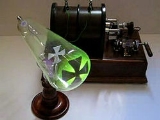
Cathode ray
Overview
Electron
The electron is a subatomic particle with a negative elementary electric charge. It has no known components or substructure; in other words, it is generally thought to be an elementary particle. An electron has a mass that is approximately 1/1836 that of the proton...
s observed in vacuum tube
Vacuum tube
In electronics, a vacuum tube, electron tube , or thermionic valve , reduced to simply "tube" or "valve" in everyday parlance, is a device that relies on the flow of electric current through a vacuum...
s. If an evacuated glass tube is equipped with two electrode
Electrode
An electrode is an electrical conductor used to make contact with a nonmetallic part of a circuit...
s and a voltage
Voltage
Voltage, otherwise known as electrical potential difference or electric tension is the difference in electric potential between two points — or the difference in electric potential energy per unit charge between two points...
is applied, the glass opposite of the negative electrode is observed to glow, due to electrons emitted from and travelling perpendicular to the cathode
Cathode
A cathode is an electrode through which electric current flows out of a polarized electrical device. Mnemonic: CCD .Cathode polarity is not always negative...
(the electrode connected to the negative terminal of the voltage supply). They were first observed in 1869 by German physicist Johann Hittorf, and were named in 1876 by Eugen Goldstein
Eugen Goldstein
Eugen Goldstein was a German physicist. He was an early investigator of discharge tubes, the discoverer of anode rays, and is sometimes credited with the discovery of the proton.- Life :...
kathodenstrahlen, or cathode rays.
Unanswered Questions
Discussions

